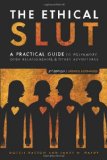I am leading a read-through of The Ethical Slut, 2nd edition. If you’d like to catch up on past installments, check the list at the bottom of the series introduction. Comments on the topics in this discussion are welcome anytime, even from people who aren’t following along in the book.
In this installment we discuss Chapter 11, “Keeping Sex Safe”

Making informed safer sex decisions are important to not just polyamorists, but anyone who is sexually active. The term itself, safer sex, is an acknowledgment that sex is never 100% safe, a fact that the authors acknowledge in the open pages of this chapter. Indeed, Easton & Hardy are of a generation that has seen several changes in the nature of ethical sex practices, as both recount growing up in an era when abortions were illegal and life-threatening. This chapter is similar to one called “Health” from the first edition of the book.
We don’t think you need to cover every portion of your anatomy with latex before you touch another human being. The goal for most of us is risk reduction, sort of like defensive driving on the freeway. Yes, a drunk could kill you at any time while you are cruising down the highway, and most of us take our best shot at safety and go on driving. -from The Ethical Slut, second edition
This chapter covers some very general risk reduction strategies, but makes a point of not telling the reader what to do — they have to choose for themselves, and with the informed consent of their partners. I appreciated that the authors emphasize that everyone needs to choose for themselves, rather than letting others decide for them. I also liked that they emphasized the need for everyone to take responsibility for safer sex, not just men in a relationship.
The authors mention practicing with masturbating a condom, which can be a good idea for people who have problems using them. I find I have little sympathy for people who insist on practicing unsafe sex because they can’t use condoms. Though I have certainly enjoyed unprotected sex with ‘fluid bonded‘ partners, I have also repeatedly had the experience where intercourse felt so good that I checked whether the condom was still on, only to discover that it very much was. A hot sexual connection is about so much more than whether your cock is wrapped or not. Condoms are a fact of most people’s sex lives these days, and you either need to learn to use them or avoid other kinds of sex — pressuring your partners is 100% unacceptable. However, I did think that when the authors mentioned men who like to masturbate with multiple condoms they should also have mentioned that “double bagging” or using multiple condoms during sex is unsafe.
Overall the chapter encourages readers to make decisions rather than just cross fingers. There is also a lot of advice about considering all your sexual options. Look at all the types of birth control and decide whats best for you. Research for yourself (on multiple reliable websites) the risk factors and ways to protect yourself from the many forms of STDs. Consider all kinds of sexual behavior other than just penis-in-vagina sex. Break out of your habits and find new roads to pleasure. I’ve had sexual experiences where I didn’t even had an orgasm, yet were still some of the most of my life.

The authors advise a very conservative attitude, which I think is smart for a lot of diseases. But I also appreciate the slightly more liberal attitude some sex experts such as Dan Savage have been taking toward diseases like herpes or non-cancer causing strains of HPV where, in reality, the worst side effect is the stigma society has placed on them. In one podcast he even memorably renamed the scary sounding Molluscum contagiosum to the more consequence-appropriate sounding name “Hello Kitty Dots.”
What choices do I make when it comes to safer sex? Right now I don’t have unprotected vaginal intercourse or anal sex with anyone, even partners I have been with a long time. I do choose to engage in unprotected oral sex acts with some lovers. I get tested for HIV, Chlamydia, Syphilis, and a few other STDs every 6 months. Right now, with my sexual network and my beliefs about the relative risks of various diseases, and considering the comfort levels of my partners, this is what works for me. In the past, I made some too-abrupt decisions about unprotected intercourse with lovers, so for now it comforts me to not be fluid-bonded in that way with anyone.
When I am beginning a new potential sexual relationship, I initiate a discussion of risk factors with my new partner as soon as it becomes clear we’re heading in that direction, including any I may be aware of my in my extended sexual network. I discuss when each of us was last tested, and let the partner know that I have had a vasectomy (even though I continue to use condoms, of course). For those who haven’t gotten into the habit, having this kind of conversation seems really scary, but I actually have found it to be refreshing and even a turn on at times, because it shows my new lover how open and honest I am about my sexual practices. In almost every case, the conversation leads almost directly onto some hot sex!
If you’d like to join the conversation in the comments, why not talk a little about what safer sex decisions you make and why. Let’s not criticize each other’s choices, but instead talk about why we’ve made the decisions we have and how we handle “the talk” with new lovers.
The Read-Along will return on Thursday, April 7 with a discussion of Chapter 12, “Childrearing.” Since I am sterile by choice and childless, If there’s anyone out there with children who would like to offer some input on this chapter, I’d love to hear it. Please get in touch!